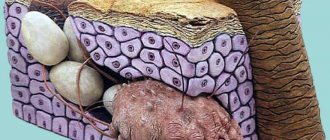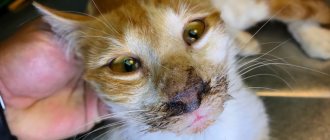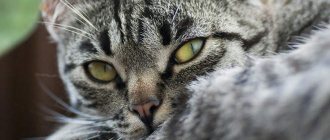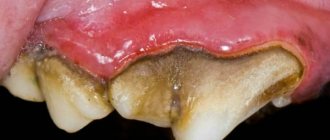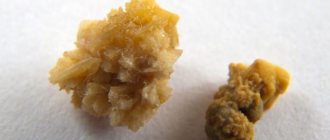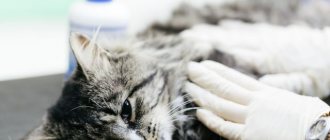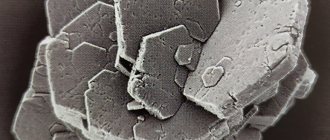Save the article:
Among all cat diseases, coronavirus infection stands out. The complexity of diagnosis, treatment and vaccination makes coronavirus in cats a dangerous contagious disease. An infectious disease, which is not always accompanied by specific symptoms, can be fatal.
What is coronavirus
global $ads_google; //data-ad-slot=”2475549904″ $ads_google = empty($ads_google) ? false : true; ?> if ($ads_google == false) {?>
$ads_google = true; ?> } ?>
Like all representatives of the non-cellular superkingdom of viruses, coronavirus consists of a protein shell and nucleic acid. The genetic component contains single-stranded RNA. The name of the virus was given by its appearance - under a microscope, the coronavirus looks like a ball with many crown-shaped protrusions on the surface.
Coronavirus in cats was first recorded by veterinarians from the United States in 1966. Experts suggest that the virus existed before, but was discovered due to increased attention to cats from nurseries and breeders in the mid-20th century. The geographic spread of the virus has no boundaries. In this case, not only domestic cats can suffer, but also other members of the family (jaguars, lynxes, cheetahs, leopards, manulas).
With a strong immune system, the cat’s body copes with the coronavirus on its own. The owner sometimes does not even notice uncomplicated gastroenteritis in a pet. The danger of the pathogen lies in its high mutation ability. When the structure of RNA changes, the activity of the virus changes. A weak immune system, hypothermia, and poor nutrition contribute to the fact that the mutated coronavirus takes hold in the body and causes serious illness.
Forms
Veterinarians distinguish three forms of coronavirus infection: asymptomatic, mild and severe. The first does not pose a threat to the pet. The cat is not sick, but is a carrier of the virus and can infect other animals. A mild form of the disease is often called dry. It develops slowly and gradually becomes chronic. The severe (or wet) form is much more dangerous, as the virus multiplies rapidly. With this course of the disease, fluid accumulates in the abdominal cavity and effusion peritonitis develops, followed by ascites. In some cases, the dry form turns into a wet form. It happens that against the background of a severe course, remission begins and the wet form turns into dry.
According to statistics, up to 5% of all cases of coronavirus infection in cats occur in severe form.
Types
Doctors distinguish two types of infection. They differ in the strains of the virus. The first is enteric coronavirus (IEC), which causes enteritis. The second is feline infectious peritonitis virus (FIPV), which appears as a result of mutation and is much more pathogenic. IPC attacks intestinal epithelial cells, causing diarrhea. The danger of HIV infection lies in the fact that the virus penetrates immune macrophage cells and destroys them in the process of reproduction. The body produces even more macrophages to fight coronavirus, which only stimulates the increase in the number of the virus.
9) The walls are pressing on me. Children are constantly naughty. I'm going crazy in quarantine. Help!
Many people are stressed due to the forced transition to remote work, quarantine after traveling to areas with a high risk of infection, and the flow of negative information. If you are afraid of getting sick, you should remember that it is normal to worry about the whole situation. You are not alone. In case of severe anxiety, consult with a psychotherapist online - this is the best solution. Moreover, there are quite a lot of services offering such a service.
Please know that the situation is not hopeless, and good behavior in the community can go a long way in combating the spread of this disease. China has now closed all of its temporary hospitals as the number of cases continues to decline. But the social and economic impacts of this pandemic could last for months, so mentally prepare for it.
Treat the situation as a new opportunity for self-development - take online courses in a new profession, learn a foreign language. In the end, the pandemic will end - and new knowledge will remain with you.
Many services have become available for free, so you can entertain yourself or engage in self-development and knowledge acquisition.
How dangerous is the virus for a cat?
global $ads_google; //data-ad-slot=”2475549904″ $ads_google = empty($ads_google) ? false : true; ?> if ($ads_google == false) {?>
$ads_google = true; ?> } ?>
During a coronavirus infection, a cat develops pathological processes in those organs that were attacked by viruses. In addition to the gastrointestinal tract, the muscular and nervous systems are affected. A sick cat may have the following negative consequences:
- ataxia (motility disorder);
- paresis or paralysis of the limbs;
- depression;
- convulsions, nystagmus.
In the wet form of the disease, dropsy of the abdominal cavity develops. This functional disorder is accompanied by weight loss and anemia. Every fifth cat has hydrops in the pleural cavity. This entails breathing problems. Later, the clinical picture is complemented by liver damage. Jaundice becomes a harbinger of the imminent death of the animal. The danger of coronavirus in cats is the high probability of death. In some cases, it is not possible to help the animal because the disease develops so rapidly.
Is it dangerous for humans?
Feline coronavirus is a specific structure that is activated only in the cat's body. Humans are resistant to this microbe. Even when mutated forms of coronavirus enter the human body, the immune system copes with foreign particles and inactivates them. Therefore, these pathogens are found only in representatives of the cat family. But a person can be a potential carrier of the virus. Through dirty hands and household items, the pathogen can be transmitted to healthy cats and cause infection in them. Therefore, maintaining hygiene rules in the house and in the yard is a prerequisite for keeping a cat.
Forms of the disease
The disease has three forms, which are conventionally divided into wet, dry and hidden. In the first case, the blood vessels of the abdominal cavity and pulmonary pleura are damaged. There is effusion of these organs, that is, exudate (fluid from small blood vessels) accumulates. In kittens, the body temperature rises greatly to 40 ° C, weakness, lack of appetite, diarrhea, and peritonitis occur.
Note! During pulmonary pleural effusion, kittens begin to wheeze and choke.
Typically, with the wet form of an infectious virus, the animal dies within a week. If this does not happen, then pancreatic dysfunction, as well as renal and pulmonary failure, are added to peritonitis.
More mature cats are susceptible to the dry form of the disease. No fluid effusion is observed. Meanwhile, in cats, motor activity decreases and there is no appetite. Diagnosing this form is quite difficult, since it occurs without visible symptoms. In the future, animals may develop kidney and liver disease, paralysis, convulsions, and paresis. Often, four-legged animals suffer from apathy or, conversely, aggression, as well as eye diseases.
The disease has three forms
In the latent form of the virus, the disease does not manifest itself in any way. Cats become virus carriers for a long time, infecting their own kind without getting sick. Over time, the latent form mutates into either dry or wet, or the disease completely recedes.
Can a kitten get sick?
Coronavirus infection can affect cats of any breed, age and health status. Veterinarians have not yet established why one organism, under equal conditions, is more resistant than another. At the same time, enough facts have already accumulated in veterinary practice to allow certain conclusions to be drawn about the disease.
There is a category of animals that are most vulnerable to the virus. It includes older cats, albinos, allergy sufferers and kittens. And although during embryonic development the virus is not transmitted to the fetus from a sick mother, a month after birth the kitten can become infected. Symptoms of the disease often appear during the period of weaning the baby from the nursing mother.
Children under 1.5 years of age have a weak immune system and when infected, their body cannot fully fight back the pathogen. The immune status is significantly strengthened when a young cat reaches the two-year mark. That is why kittens require increased attention and care.
Caring for an infected person
During the treatment period, it is important that your pet receives appropriate care. The diet should also be reviewed. For example, if he received industrial feed before his illness, now he needs to be switched to natural food. The transition should be gradual, but mandatory. The consumption of protein contained in meat products is determined by the need to restore the tissue of the affected intestine as quickly as possible.
The cat should drink a sufficient amount of clean water. On the recommendation of a veterinarian, the patient is given decoctions of rosehip or stinging nettle. The doctor prescribes vitamins that help boost the pet’s immune system. Regular deworming is mandatory to maintain a normal standard of living.
Unsanitary living conditions negatively affect a cat’s recovery, so cleanliness is needed not only for the cat itself, but also among bowls, trays, various hygiene items, and toys. When two or more relatives live together in the same territory, they are provided with separate plates and toiletries.
Intestinal infections are treated only under the supervision of a veterinarian. Only a specialist can monitor the patient’s condition or change the treatment conditions during regular examination of the infected patient.
How can an animal become infected?
global $ads_google; //data-ad-slot=”2475549904″ $ads_google = empty($ads_google) ? false : true; ?> if ($ads_google == false) {?>
$ads_google = true; ?> } ?>
The infection is contagious, therefore, among all sources of infection, the virus-carrying animal takes first place. It doesn't matter whether he shows symptoms or not. In this regard, any accumulation of cats on the street, nurseries, shelters, and even accidental contact with a sick individual pose a danger.
Indirect communication through shared care items also plays a role. The source of the coronavirus can be food and water bowls, a tray, and beds. They contain saliva or traces of excrement through which the microbe is transmitted. After a sick cat, the virus lives on objects for another 24 hours, after which it is destroyed. Eating the feces of relatives on the street is also a risk factor for cats, since the coronavirus remains viable in them for much longer - up to several months.
Routes of infection
Coronavirus in cats is transmitted mainly through infected individuals who have not been isolated, and also under the following circumstances:
— contact with the feces of an infected animal;
- use of common trays, bowls and toys;
- through the owner's shoes.
We also note that there is one factor that sharply increases the risk of spreading the infection. We are talking about crowded keeping of animals in one apartment, where they are not isolated, but communicate freely with each other. If there are 5-10 cats (or even more) in an apartment and one of them gets sick, then most likely everyone will get sick. By the way, this is why at the Murkosha shelter pets are kept in separate enclosures - for the shelter this is the only possible way to prevent animals (some of which may be sick) from contacting each other and reducing the risk of virus transmission to zero.
Read about it: Why we keep cats in cages
There is also an opinion that in carriers of the infection, the disease can begin to progress under all sorts of stress: moving to a new home, the appearance of another animal, surgical interventions, early pregnancies, weaning. Coronavirus can also be transmitted to a kitten in the womb if the mother was sick.
Symptoms of coronavirus infection
Statistics show that 90% of all cats are infected with the virus, but only 10% develop the disease. Lifelong carriage is observed in 13% of pets. With a very mild course of the disease, no external manifestations are noted. For more severe cases, the symptoms of coronavirus in a cat depend on the strain, the age of the pet and its health.
Sign of enteritis
Symptoms of intestinal coronavirus, which occurs in a mild form, are nonspecific and therefore are often similar to signs of other diseases. The main markers are apathy and lethargic behavior of the animal, decreased appetite, thirst, upset stool, temperature fluctuations, mucous discharge from the nose, and lacrimation. The symptomatic picture can be so blurred that it is not always possible to make a correct diagnosis. Viral enteritis is often confused with poisoning or overeating.
Sign of infectious peritonitis
global $ads_google; //data-ad-slot=”2475549904″ $ads_google = empty($ads_google) ? false : true; ?> if ($ads_google == false) {?>
$ads_google = true; ?> } ?>
Coronavirus in cats in severe form can be suspected based on a whole range of serious manifestations. Since the pathogen is able to penetrate different organs, disturbances occur in the functioning of many functional systems. Characteristic signs of infectious peritonitis of the FIP type are:
- frequent vomiting;
- diarrhea, possibly bloody;
- heat;
- fear of light;
- weight loss;
- lethargy;
- yellowness of mucous membranes;
- faded gums;
- yellowness of the ears;
- cough;
- refusal of food;
- bloating.
Signs of coronavirus do not always appear in such a complete set. Their combination is influenced by the general condition of the animal at the onset of the disease. The very first symptoms of coronavirus are intestinal disorders, then they are followed by kidney and liver disorders. At the very last stages, when the nervous system is damaged, the cat develops convulsions, loss of coordination, and paresis.
Diagnosis and tests for coronavirus
It is very difficult to determine for sure that a cat has an intestinal infection. The clinical picture is similar to other diseases (toxoplasmosis, viral leukemia, immunodeficiency). In most cases, an indicative symptom of coronavirus in a cat at a late stage is an enlarged abdomen. Bloating occurs due to the accumulation of fluid in the abdominal and pleural cavities. But even in this case, an error is possible. Diagnostics helps determine the cause of a cat’s painful condition.
The veterinarian first writes out a referral for immunochromatographic analysis (ICA) and polymer chain reaction (PCR) of blood and feces. The material for these studies is stool, rectal swab, and blood. PCR helps determine the presence of viral RNA. But this test often gives false positive or false negative results. Therefore, it is repeated three times for 14 days. If the answer is negative, then we can say with confidence that there is no microflora containing coronavirus in the cat’s body.
In case of a positive result, it is advisable to conduct additional tests to clarify the diagnosis. For this purpose, a serological, biochemical blood test and a titer test for blood protein fractions are prescribed. The latter allows you to determine the concentration of antibodies, and, therefore, the severity of the disease. Serological testing can also produce erroneous results, so it is repeated several times. If laboratory tests give a clear indication of peritonitis, a puncture from the abdominal cavity is taken from the sick animal. Studying ascites fluid allows you to clarify the diagnosis, stage of the disease and develop a treatment regimen.
Virus carriage does not mean the presence of a mutated pathogen that causes infectious peritonitis.
Treatment of coronavirus
After the discovery of intestinal coronavirus, scientists have not yet developed a single effective treatment regimen and have not invented an anti-coronavirus drug that would help fight the infection. It is not possible to treat only with antibiotics, the action of which is primarily aimed at bacteria. Only when a bacterial infection occurs against the background of a viral infection are antibiotic drugs included in the prescription list. Treatment of coronavirus is based on eliminating symptoms, correcting the immune system, and alleviating the condition of the sick cat.
General therapy
A sick cat is prescribed antiviral medications, corticosteroids to relieve inflammation, and antibiotics to extinguish bacterial flora. In parallel, therapy includes immunomodulators and vitamins that stimulate the natural defense mechanisms in the cat’s body. The choice of these drugs should only be made by a veterinarian, since many strong immunomodulators intended for humans are contraindicated in severe cases of FIP in cats.
To relieve intoxication and facilitate the functioning of the liver and intestines, the veterinarian prescribes enterosorbents. To relieve spasms, use no-shpu or papaverine in injections. If one of the symptoms is vomiting, then Metoclopramide, Prochlorpromazine or any other antiemetic drug is prescribed to eliminate it.
Enteritis therapy
The mild form of the disease is more difficult to diagnose, but much easier to treat. After determining the cause of the disease, the pet’s amount of food is limited. On the first day, water fasting is indicated for the cat. In case of severe dehydration, droppers are given with a solution of vitamins and glucose. If diarrhea is pronounced, then the pet is prescribed medications with a fixing effect.
On the second day, the furry patient is switched to oatmeal without milk, which plays not only a nutritional, but also an adsorptive role. Starting from the fourth day, a small amount of lean minced meat is introduced into the menu.
If, during the treatment of coronavirus, the cat’s temperature does not subside and the symptoms of intestinal distress do not disappear, veterinarians supplement therapy with antibiotics to exclude complications. The recovery course is completed by taking vitamin complexes, probiotics and prebiotics, which restore normal intestinal microflora.
Treatment of peritonitis
global $ads_google; //data-ad-slot=”2475549904″ $ads_google = empty($ads_google) ? false : true; ?> if ($ads_google == false) {?>
$ads_google = true; ?> } ?>
Although the percentage of severe forms of coronavirus infection is not very high compared to mild ones, treating it is problematic. Veterinarians have developed a general set of measures that can support the body. The first block of procedures is aimed at relieving pain. For this purpose, an ice compress is used on the abdominal area and painkillers.
Just as in the case of enteritis, the cat is prescribed antiviral, antibiotic, corticosteroid, diuretic, and vitamin preparations. In severe cases of the disease, some medications are administered as subcutaneous injections. A little later, immunotherapy using recombinant drugs (Roncoleukin, Betaleukin) is added.
To make breathing easier for the animal, a puncture of the abdominal cavity is performed to remove excess exudate. However, in most cases this measure is temporary, as the fluid accumulates again. Enteral lavage with saline solution is used to cleanse the gastrointestinal tract.
Treatment of the wet form of coronavirus infection is aimed at preventing complications.
Prevention and vaccination of coronavirus
The best prevention option would be a coronavirus vaccine. Work on its development has been ongoing since the early 90s of the 20th century. American scientists have obtained the Primucell vaccine, which is administered intranasally into the cat’s body. Despite the high cost of the vaccine, its effectiveness is not high enough. In addition, the coronavirus vaccine is rarely used in Russia.
Since intestinal coronavirus is most often found in large cat populations, preventive measures include mass serological surveys of shelters and nurseries. Carriers and already sick cats and kittens are isolated. This measure, in parallel with antiviral prophylaxis, makes it possible to keep under control a dangerous disease spreading among purebred animals.
To avoid treating cats in the future, you should keep the premises clean. It is recommended to regularly treat cat personal hygiene items with disinfectants. Coronavirus dies at high temperatures, in ammonia, 3% sodium hypochlorite solution.
To maintain a cat’s immunity against coronavirus, it is necessary to organize a nutritious diet, monitor the deworming schedule, neutralize stressful situations, and create physical activity according to age. Such prevention can serve as a good alternative to vaccination.
global $ads_google; //data-ad-slot=”2475549904″ $ads_google = empty($ads_google) ? false : true; ?> if ($ads_google == false) {?> $ads_google = true; ?> } ?>
